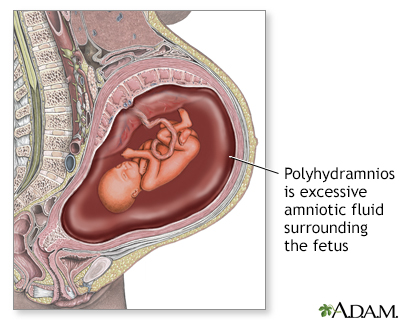Polyhydramnios
Pregnancy - polyhydramnios; Hydramnios - polyhydramnios
Polyhydramnios occurs when too much amniotic fluid builds up during pregnancy. It is also called amniotic fluid disorder, or hydramnios.
Images

I Would Like to Learn About:
Considerations
Amniotic fluid is the liquid that surrounds the baby in the womb (uterus). It comes from the baby's kidneys and developing urinary system, and then it goes into the uterus from the baby's urine. The fluid is absorbed when the baby swallows it and through breathing motions.
While in the womb, the baby floats in the amniotic fluid. It surrounds and cushions the infant during pregnancy. The amount of amniotic fluid is greatest at 34 to 36 weeks of pregnancy. Then the amount slowly decreases until the baby is born.
The amniotic fluid:
- Allows the baby to move in the womb, promoting muscle and bone growth
- Helps the baby's lungs to develop
- Protects the baby from heat loss by keeping the temperature constant
- Cushions and protects the baby from sudden blows from outside the womb
Causes
Polyhydramnios can occur if the baby does not swallow and absorb amniotic fluid in normal amounts. This can happen if the baby has certain health problems, including:
- Gastrointestinal disorders, such as duodenal atresia, esophageal atresia, gastroschisis, and diaphragmatic hernia
- Brain and nervous system problems, such as anencephaly and myotonic dystrophy
- Achondroplasia
- Beckwith-Wiedemann syndrome
It can also happen if the mother has poorly controlled diabetes.
Polyhydramnios also may occur if too much fluid is produced. This may be due to:
- Certain lung disorders in the baby
- Multiple pregnancy (for example, twins or triplets)
- Hydrops fetalis in the baby
Sometimes, no specific cause is found.
When to Contact a Medical Professional
Contact your health care provider if you are pregnant and notice that your belly is getting large very quickly.
What to Expect at Your Office Visit
Your provider measures the size of your belly at every visit. This shows the size of your womb. If your womb is growing faster than expected, or it is larger than normal for your baby's gestational age, the provider may:
- Have you come back sooner than normal to check it again
- Do an ultrasound of your womb
If your provider finds a birth defect, you may need amniocentesis to test for a genetic defect in your baby.
Mild polyhydramnios that shows up later in pregnancy often doesn't cause serious problems.
Severe polyhydramnios may be treated with medicine or by having extra fluid removed.
Women with polyhydramnios are more likely to go into early labor. The baby will need to be delivered in a hospital. That way, the providers can immediately check the health of the mother and baby and give treatment if needed.
Related Information
Amniotic fluidReferences
Buhimschi CS, Mesiano S, Muglia LJ. Pathogenesis of spontaneous preterm birth. In: Lockwood CJ, Copel JA, Dugoff L, eds. Creasy and Resnik's Maternal-Fetal Medicine: Principles and Practice. 9th ed. Philadelphia, PA: Elsevier; 2023:chap 7.
Gilbert WM. Amniotic fluid disorders. In: Landon MB, Galan HL, Jauniaux ERM, et al, eds. Gabbe's Obstetrics: Normal and Problem Pregnancies. 8th ed. Philadelphia, PA: Elsevier; 2021:chap 28.
Suhrie KR, Tabbah SM. The fetus. In: Kliegman RM, St. Geme JW, Blum NJ, Shah SS, Tasker RC, Wilson KM, eds. Nelson Textbook of Pediatrics. 21st ed. Philadelphia, PA: Elsevier; 2020:chap 115.
BACK TO TOPReview Date: 4/25/2023
Reviewed By: Charles I. Schwartz, MD, FAAP, Clinical Assistant Professor of Pediatrics, Perelman School of Medicine at the University of Pennsylvania, General Pediatrician at PennCare for Kids, Phoenixville, PA. Also reviewed by David C. Dugdale, MD, Medical Director, Brenda Conaway, Editorial Director, and the A.D.A.M. Editorial team.

Health Content Provider
06/01/2025
|
A.D.A.M., Inc. is accredited by URAC, for Health Content Provider (www.urac.org). URAC's accreditation program is an independent audit to verify that A.D.A.M. follows rigorous standards of quality and accountability. A.D.A.M. is among the first to achieve this important distinction for online health information and services. Learn more about A.D.A.M.'s editorial policy, editorial process and privacy policy. A.D.A.M. is also a founding member of Hi-Ethics. This site complied with the HONcode standard for trustworthy health information from 1995 to 2022, after which HON (Health On the Net, a not-for-profit organization that promoted transparent and reliable health information online) was discontinued. |
The information provided herein should not be used during any medical emergency or for the diagnosis or treatment of any medical condition. A licensed medical professional should be consulted for diagnosis and treatment of any and all medical conditions. Links to other sites are provided for information only -- they do not constitute endorsements of those other sites. © 1997- 2025 A.D.A.M., a business unit of Ebix, Inc. Any duplication or distribution of the information contained herein is strictly prohibited.
